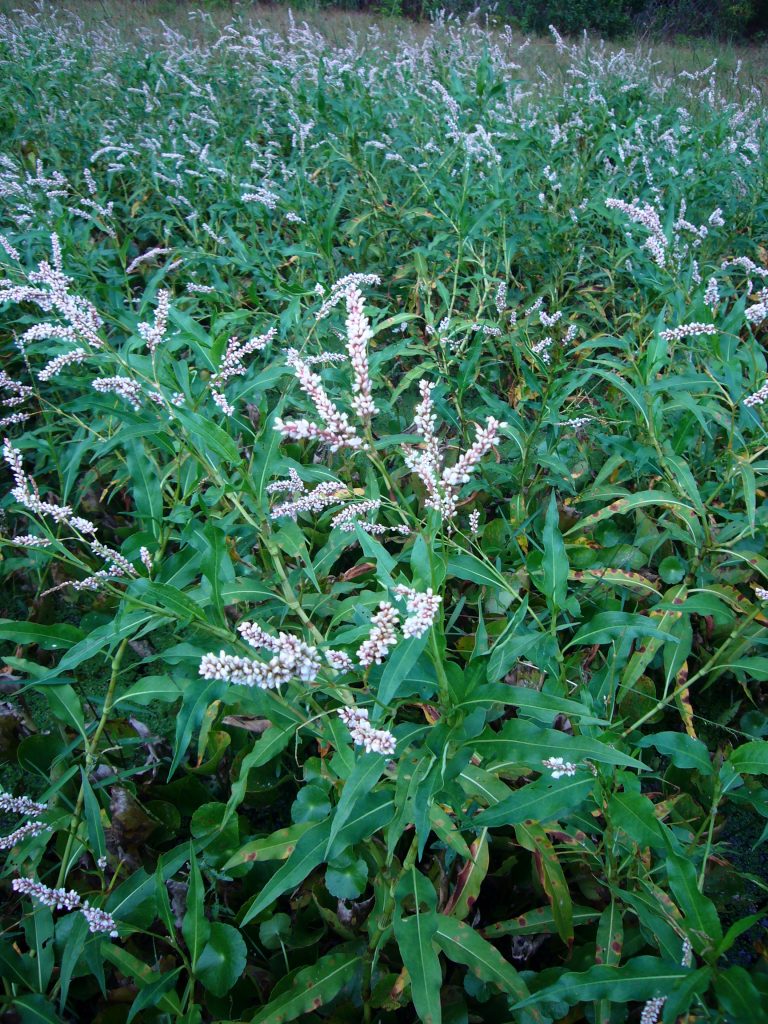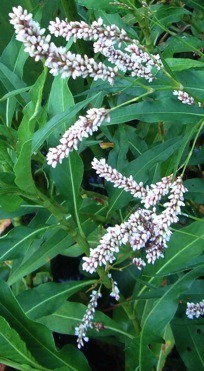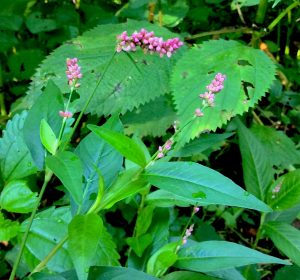
Look for Smartweed in low, damp areas such as clean ditches. Photo by Green Deane
Polygonum punctatum: Smartweed

The blossoms are hot and bitter. Photo by Green Deane
I can remember my first taste of a smartweed leaf… kind of like trying a piece of burning paper. Indeed, a lot of plants resemble smartweed but one quick taste and you’ll know if you’ve got the right plant: If it isn’t very peppery, you picked wrong. Actually, the burn is not immediate. It takes a few seconds to kick in and then it intensifies. And about the time you wish it would stop intensifying it’s just getting started. Word to the wise, use sparingly and try only a very small piece to start with chewing between teeth and tongue.
It’s a little hard to stuff inside the head, but the smartweed, Polygonum punctatum, (pol-IG-on-um punk-TAY-tum) is in the the buckwheat family, but you would never use it on morning pancakes. It’s for seasoning, soups, and perhaps salads. Not only is it burning hot but some varieties, especially P. hydropiperoides, (hye-dro-pie-per-OY-dees) are also vasoconstrictors. So if you have high blood pressure, go easy on those species. It’s all right as a spice, a bit much as a pot herb.
The Smartweed is common throughout North American and nearly year round in the southern range. Actually it is easy to identify even when brown dead and is still peppery. It has freely branching stems and a lot of joints which gives the plant its name. Polygonum is Greek for many knees. Punctatum means dotted, referring to dots on the tepals, and indeed it is also called Dotted Smartweed. It’s a fine plant for seasoning while camp cooking, but can overwhelm like cayenne pepper. Also be careful because some people can develop dermatitis from it.

Blossoms can be be pink or white depending on the species. Photo by Green Deane
There are three species locally, all useable: The P. punctatum as well as P. densifolrum (compactly flowered) and the aforementioned P. hydropiperoides (water pepper.) P. hydropiperoides has tannins, rutin (3% in leaves) quercitin, kaempferol and some protein. It is considered a diuretic and has been used to stop intestinal and uterine bleeding, hasten menstruation and to treat hemorrhoids. It has many more applications as well. The Indians also cooked the leaves of the trio and ate of them sparingly. It’s also a common waterfowl food. If you crush a bunch and put it in a small body of water it will force the fish to float to the top by interrupting with their oxygen uptake (as does American Beautyberry.)
I saw some P. hydropiperoides in Mead Gardens, Winter Park, Fla., the day I originally wrote this article. It was flowering and taking on a bit of fall red. It had been a while since I had seen the P. hydropiperoides, the P. punctatum being the one my path crosses most often. Soooo, I tried a good part of a leaf…. the hole in my tongue should heal in a few days. The blossoms are hot as well but are also bitter.
Some Polygonums have edible roots, perhaps the best know is P. bistorta, a Eurasian import. The roots are first soaked in water then cooked in embers. Or it can be chopped up, soaked in many changes of water, then passed through a mill to make a puree. The bulbs of the P. viviparum have been eaten raw but they are better roasted. The roots of the Polygonum multiflorum are also edible raw or cooked as are the roots of the Polygonum bistortoides The seeds of the Polygonum douglassii, Polygonum aviculare and the European Polygonum convolvulus have been eaten since mesolithic times.
And while the Smartweed is called “many knees” at one time its name was arsesmart. I have never found any reference to what chemical(s) make the species peppery. Lastly, I have a video on the Smartweed on You Tube… made it in the rain… dedicated I am…
Green Deane’s “Itemized” Plant Profile
IDENTIFICATION: P. punctatum: Alternate leaves are smooth-edged, lance shaped, willow-like, one to six inches long, leaf base forms sheath around stem. Young leaves flat, older leave can be wavy, The stems are often reddish, flowers are small, pink or white in dense clusters from the leaf joints or stem apices. It can grow to four feet or more but is usually smaller.
TIME OF YEAR: Year round in Florida, seasonal elsewhere, blooms July to first frost.
ENVIRONMENT: It likes moist areas. I often find it in the center part of old woods roads where they dip down and collect water or stay moist.
METHOD OF PREPARATION: In Asia the seedlings (sprouts) are collected and used like spicy radish sprouts for a hot flavor. Mature leaves and stems chopped up and used sparingly as pepper, leaves and stems boils in soups, again sparingly. Numerous herbal applications. The roots of some species are edible cooked, some require a little cooking, others require much cooking. The seeds of some are also edible. Check with a local expert about your local Polygonum.
HERB BLURB
A Mem-Inst-Oswaldo-Cruz. 2001 Aug; 96(6): 831-3. Abstract:Polygonum punctatum (Polygonaceae) is an herb known in some regions of Brazil as “erva-de-bicho” and is used to treat intestinal disorders. The dichloromethane extract of the aerial parts of this plant showed strong activity in a bioautographic assay with the fungus Cladosporium sphaerospermum. The bioassay-guided chemical fractionation of this extract afforded the sesquiterpene dialdehyde polygodial as the active constituent. The presence of this compound with antibiotic, anti-inflammatory and anti-hyperalgesic properties in “erva-de-bicho” may account for the effects attributed by folk medicine to this plant species.

